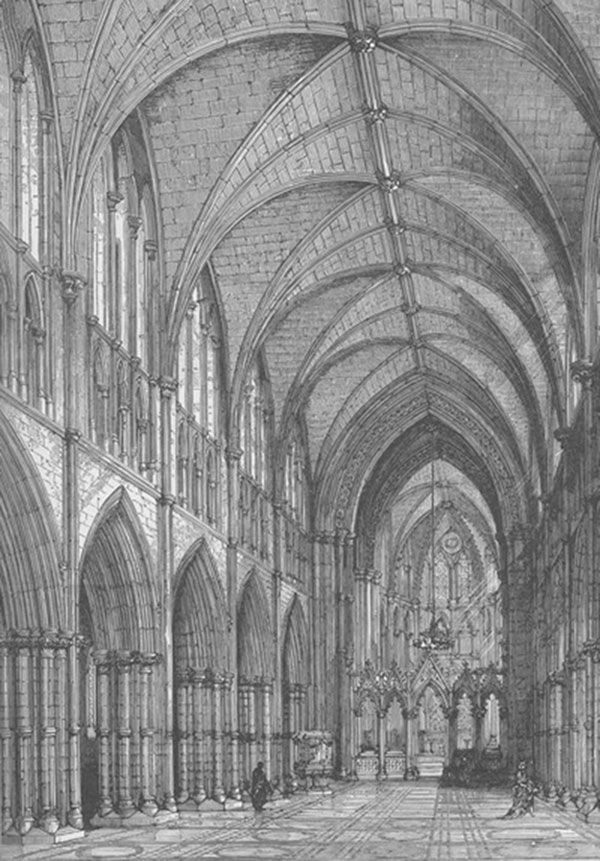Christ Church Cathedral, Dublin - Irish Pictures (1888)
From Irish Pictures Drawn with Pen and Pencil (1888) by Richard Lovett
Chapter 1: Ireland’s Eye … continued
« Previous Page | Start of Chapter | Book Contents | Next Page »
Only a few hundred yards separate St. Patrick's from the sister cathedral Christ Church. It is supposed to stand upon the site of the old Celtic dun or fort. It was founded in 1038, and completed in the following century by Richard Strongbow and others in conjunction with the Archbishop of Dublin, Laurence O'Toole. In 1562 the greater part of the structure fell in; and by subsequent restorations and vicissitudes most of the original building has disappeared. There is some reason to believe that originally it was a finer structure than St. Patrick's. Like its sister, it owes its present complete and beautiful appearance to the liberality of a Dublin brewer, Mr. Roe, who expended about a quarter of a million sterling upon it. The peculiar plan of the original choir was ascertained by examination of the crypts, and closely followed in the restoration. A short apsidal choir or presbytery stands to the east of the central tower, and around this an aisle or processional path runs, and beyond this to the east are two chapels, the smaller adjoining the choir. A Synod House for the meetings of the disestablished Episcopal Church of Ireland was erected and connected by a passage with the west end of the cathedral, the tower was raised, and the whole edifice practically rebuilt. It belongs to the transitional style of architecture. A few years ago Mr. Drew, architect to Christ Church, discovered the remains of the Chapter House, near which were formerly the old Law Courts of Dublin, and the narrow passage known as Hell. These remains are now carefully preserved. A monument ascribed to the famous Earl of Pembroke, Richard Strongbow, is placed in the nave. In 1487 Lambert Simnel, the impostor, was crowned here. In mediaeval times the cathedral was rich in MSS., shrines and other relics, possessing, among others, a bachall or walking-staff, said to have belonged to St. Patrick.
A short walk through a very unsavoury neighbourhood brings the visitor from Christ Church to the Liffey, and immediately before him on the north bank he sees another noted structure—the Four Courts of Dublin, one of the most imposing buildings in the city, and one which, unlike some of the others, has remained true throughout its history to the objects for which it was built. It occupies an oblong, having a frontage on the river of 440 feet. The foundation stone was laid in 1786, it was opened for business in 1797, and it cost about £200,000. It consists of a central block of building, surmounted by a circular lantern and dome, one of the landmarks of the metropolis. This building is flanked by squares connected with each other and with the main entrance by arcades. Each angle of the main building is occupied by one of the superior courts, viz., Chancery, Queen's Bench, Common Pleas, and Exchequer, whence the name of the pile. The centre under the dome is left free for the meeting of lawyers and clients, and all who have business there, or who are drawn thither by curiosity. A description written fifty years ago applies to it to-day: 'The handsome and towering dome lights the great hall of the Courts, an object of just admiration from its chaste and lofty appearance and proportions. During term time it is crowded with lawyers and pickpockets, strangers and stragglers, the fleeced and the fleecing, the hopeful and the hopeless, the anxious and the careless. At such a period of bustle, a visitor, as a Picture of Dublin benevolently forewarns him, "should look to his pockets."'[8]
NOTES
[8] Dublin Penny Journal, i. 143.
« Previous Page | Start of Chapter | Book Contents | Next Page »

